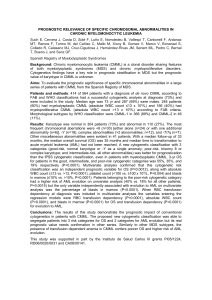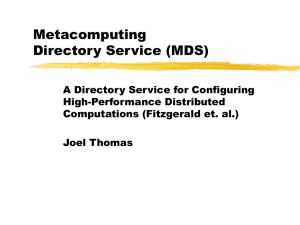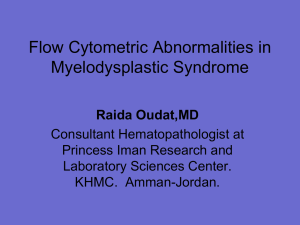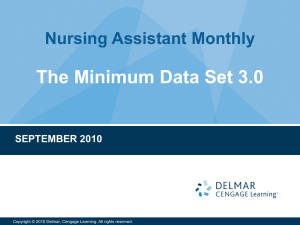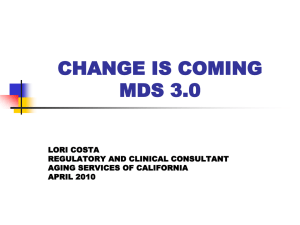CMML Is there anything new? - Chronice Myeloid Leukemia
advertisement
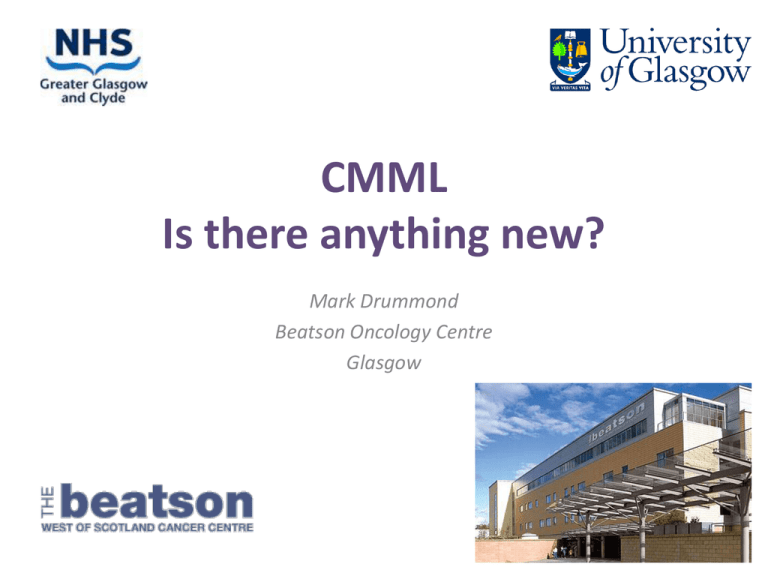
CMML Is there anything new? Mark Drummond Beatson Oncology Centre Glasgow CMML Update • Background • Diagnosis • Prognosis • Treatment “ A Disorder lost in Classification….” 1982 Myelodysplastic Syndrome FAB Group1 1994 CMML-MD vs CMML-MP* FAB Group2 2001 MDS / MPD WHO3 2008 CMML-1 / CMML-2** WHO4 1984 Blood, 63. * WCC > 13 x 109/L 1Bennet ** BM Blasts <10% or 10-20% et al, 1982; BJH, 51, 189-1999: 2Bennet et al, 1994; BJH, 87, 746-754: 3Vardiman et al, WHO Classification of Tumours of Haematopoietic and Lymphoid Tissues 2001: : 4Vardiman et al, WHO Classification of Tumours of Haematopoietic and Lymphoid Tissues 2008. WHO 2008 • PB monocytosis >1.0 x 109/L (usually >10% of leucocytes) • Absence of BCR-ABL • No rearrangement of PDGFRA or PDGFRB (exclude in eosinophilia) • <20% blasts in Blood and Marrow (includes myeloblasts, monoblasts and promonocytes) • Dysplasia in 1 or more myeloid lineage Demographics • Incidence: WHO ≈ 4 / 100,000 (WHO 2008) 0.46 / 100,000 (Thames Cancer Registry*) 0.7 / 100,000 (www.hmrn.org) 270 – 420 cases p.a. in UK • Age: WHO 65 – 75 years (WHO 2008) 76 years (www.hmrn.org) *Haematologica 2006; 91:1400-1404. A Spectrum of Disease? AML M4 or M5 (30%)* CMML – MDS • • • WCC < 13 x 60%* Cytopaenias Median OS 16-31 months CMML – 1 (85%)* • Median OS 20 months** 109/L FAB, 1994 CMML – MPD • • • • • 40%* Leucocytosis Organomegaly Karyotypic evolution Median OS 11-17 months CMML – 2 (15%)* • Median OS 15 months** *Such et al, 2013, Blood, Prepublished online 31.1.2013. ** Germing et al, 2007, Haematologica, 92, 974 – 977. Diagnosis Diagnostics – Lots of morphological variables, therefore very heterogeneous – Reactive vs. clonal monocytosis: Elderly patients, comorbidities, other reasons for cytopaenias & monocytosis. – Monocytes difficult to assess in marrow (asp & trephine); granulocytic hyperplasia is striking – CMML vs. AML: overlapping morphology & flow. Transforming CMML –mixed picture. Blasts generally CD34 negative. Monocyte / Monoblast Morphology Monoblast Promonocyte AML (≥ 20%) Immature Monocyte CMML IWGM-MDS: Haematologica 2009; 94 (7): 994-999. Morphology X 100, oil Immersion Flow Cytometry is Helpful…. Monoblast Promonocyte Immature Monocyte CMML CD14 - -/+ + ++ + CD64 ++ ++ ++ + + / ++ CD117 + - - - - MPO - +/- + + + *Xu et al, Am J Path, 2005; 124 (5): 799-806.**Kern et al, Leuk Lymp, 2011; 52(1); 92-100 Reduced HLA-DR Aberrant CD56 Aberrant CD2 Aberrant Markers Common 99% 83% CD56 expressed in ≈ 80% CMML (40% AMoL) • Nice technique for PB • Very promiscuous antigen - caution • May be induced in reactive states &/or G-CSF / GM-CSF administration Trephine Histology • Hypercellular • Granulocytic Hyperplasia • Excess monocytes; best appreciated with ICC (e.g. CD68) • Variable reticulin fibrosis • May detect other causes of monocytosis or additional pathology (e.g. SM-AHNMD) Diagnosis: Summary • Cytology (blood +/- marrow) crucial • Flow useful to confirm abnormal monocytes & maturational stage • Trephine confirms myeloproliferative aspects • Genetic testing: cytogenetics (non-specific, abnormal in 30%), role of mutation analysis in future. Molecular Abnormalities TET2 Mutations Most common abnormality in CMML ≈ 50% of cases mutated Loss of protein function tumour suppressor role ? Found in CD34+ cells and Tcells Prognostic impact controversial Molecular Heterogeneity in CMML Epigenetic Regulation Signalling Pathways TET2 ≈ 50% ? outcome ASXL1 ≈ 40% MPD phenotype, poor outcome EZH2 ≈ 10% Poor outcome JAK2 V617F ≈ 10% MPD phenotype CBL ≈ 20% KRAS / NRAS ≈ 30% mRNA Splicing MPD phenotype, disease progression SRSF2 ≈ 50% Transcription RUNX1 ≈ 20% Metabolism IDH2 ≈ 10% 93% of CMML has one or more mutations in these genes Prognosis “ A Disorder lost in Prognostication….” 1Aul 1992 Düsseldorf Score Dusseldorf Registry1 1997 IPSS WCC >12 x 109 excluded2 2002 MD Anderson Score 213 CMML pts3 2011 Cytogenetic Risk Score Spanish MDS Registry4 2012 IPSS-R WCC >12 x 109 excluded5 2013 CPSS Spanish MDS Registry6 et al, Leukaemia 1992, 6, 52-59; 2Greenberg et al, Blood, 1997, 89 (6) 2079;3Onida et al, Blood 2002, 90 (3), 840; 4Such et al, Haematologica 2011, 96 (3), 375; 5Greenberg et al, Blood 2012, 120 (12), 2454; 6Such et al, Blood 2013 epub ahead of print Cytogenetic Risk Classification in CMML • 414 pts from Spanish registry (1980-2008) – 110 (27%) had abnormal karyotype • 3 Cytogenetic Risk categories identified: – LOW RISK (78%): Normal, or isolated loss of Y – NORMAL RISK (9%): All other – HIGH RISK (12%): Trisomy 8, abnormalities of chr7, or complex Such et al, Haematologica 2011, 96 (3) 5yr OS 35% 26% 4% CMML-Specific Prognostic Scoring System (CPSS) Such et al, Blood 2013 epub ahead of print CMML-Specific Prognostic Scoring System (CPSS) Median OS Low (41%): 72 Months Int-1 (29%): 31 Months Int-2 (26%): 13 months High (4%): 5 months Such et al, Blood 2013 epub ahead of print Treatment Patient / Doctor Treatment Goals in CMML Watch & wait Palliation Disease Modification Supportive Care ? Demethylating Agents Hydroxycarbamide LD Ara C ? Experimental therapies Steroids HD chemo for sAML Cure Allo SCT (+/- HD chemo pretransplant) MS 20 months. p<0.0001 AML – 27%, ns MS 9 months, p<0.001 AML – 38%, ns Wattel et al, Blood 1996; 2480 - 2487 Palliation / LD Chemo / HD Chemo • LD ARA-C – No studies specific to CMML, some reponses reported – Cytoreductive: use in extramedullary disease, pts with poor response to hydroxy • Prednisilone – Symptomatic control; skin and pleural effusions. • HD Chemo – No role in isolation – Pre allo SCT (1 or 2 cycles) – ‘intensive’ palliation? Patient / Doctor Treatment Goals in CMML Palliation Transfusion support Hydroxycarbamide LD Ara C Steroids Disease Modification ? Demethylating Agents ? Experimental therapies Cure Allo SCT (+/- HD chemo pre-transplant) Male Cases Female Cases Male Rate Female Rate 100 12 ≈ 85-90% of patients are >65 90 10 80 70 rate per 100,000 population estimated cases UK 8 60 50 6 40 4 30 20 2 10 0 0 0-4 5-9 www.hmrn.org 10-14 15-19 20-24 25-29 30-34 35-39 40-44 45-49 50-54 55-59 60-64 65-69 70-74 75-79 age at diagnosis (years) 80+ Treatment Patterns Spanish Registry (414 pts, 1980 – 2008)1 • • • • • • Supportive care (100%) ESA (42%) HC (16%) AML-type Intensive Chemo (6%) Allo SCT (<1%) No Demethylating agents used French Transplant Registry2 • 73 allos done 1992 – 2009 • approx 1.5 % of all cases of CMML transplanted based on incidence of 0.47 / 100,000 p.a.3 1Such et al, Haematologica 2011, 96 (3); 2Park et al, EJH 2013; 3Drummond 2013, Back of an envelope, based on incidence Transplant Outcome: 1992-2009 73 pts 1992 – 2009 Median age 53 43 RIC / 30 MA; 41 sibling / 32 VUD Multivariate analysis Splenomegaly at transplant (HR 0.48) Transplant pre 2004 (HR 0.42) ?cytogenetic risk groups 1/3rd: Cured 1/3rd: TRM 1/3rd: Relapse Park et al, 2013, EJH; epub ahead of print. Patient / Doctor Treatment Goals in CMML Palliation Transfusion support Hydroxycarbamide LD Ara C Steroids Disease Modification ? Demethylating Agents ? Experimental therapies Cure Allo SCT (+/- HD chemo pre-transplant) AZA 001 Study. Fenaux et al 2009. The Lancet Oncology, 10;3:223-232 24.5 months V 15.0 months. Median FU 21.1 months SMC Advice Sept 2011 Azacitidine is recommended as a treatment option for adults who are not eligible for HSC and have: 1. 2. 3. Int-2 or HR MDS according to IPSS CMML with 10-29% marrow blasts and without myeloproliferative disorder* AML with 20-30% marrow blasts and multi-lineage dysplasia, according to the WHO classification. • CMML in AZA001 study had WCC <13 x 109/l* • Identical to EMEA licensed indications • (approved by NICE 2010 on back of pt access scheme. Approved by FDA in 2004; EMEA 2009). Azacytidine in CMML: does it work? • Europe: Registration Study (2009) – AZA001 trial – 11 pts with CMML; not separately reported • USA: Registration Studies (2004) – 3 studies (CALGB 9221, 8921, 8421) – Total of 19 patients with CMML – ORR (CR + PR, MDS criteria): 15.8% Summary of Studies of Demethylating Agents in CMML Year Drug Number of subjects Single Centre? Response 2011 Azacitidine 38 Yes, Retrospective 39% ORR 11% CR 25% HI 2012 Azacitidine 10 Yes, Retrospective 60% ORR 40% CR 2007 Decitabine 19 Yes 69% ORR 58% CR 11% HI 2008 Decitabine 31 No ORR 25% CR 14% PR 11% HI 11% 2011 Decitabine 39 No ORR 38% CR 10% Marrow resp 21% In order: 2011 Costa et al, Cancer 117, 2690-2696; 2012 Thorpe et al, Leuk Res, 36, 1071-1073; 2007 Aribi et al, Cancer 109, 713717; 2008 Wijermans et al, Leuk Res 32, 587-591; 2011 Braun et al, Blood 118, 3824-3830. • A phase 2 study of azacitidine in chronic myelomonocytic leukaemia (CMML) • Supported by the NCRI Haematological Oncology MDS Subgroup • Sponsored by Leeds Teaching Hospitals NHS Trust • EudraCT Number: 2008-006349-23 Recruitment & Treatment 32 patients recruited (11 centres) Jan 2010 - August 2010 Median age 70 (57 – 85); 67% male 2 pts received <1 cycle 14 pts < intended 6 cycles (most progressed) 16 pts ≥ 6 cycles Drummond et al, abstract 0869, EHA 2012 Results Drummond et al, abstract 0869, EHA 2012 Results • 20 patients transfusion dependent at diagnosis; 6 became transfusion independent • 5/7 pts on Hydroxycarbamide were able to stop this drug • Only 1/5 patients with skin lesions at outset demonstrated resolution • Median duration of responses 7.5 months Drummond et al, abstract 0869, EHA 2012 Drummond et al, abstract 0869, EHA 2012 Conclusions… “ Clinically meaningful responses (including CR, GR, and PR) were limited (10-17% depending on response criteria).” 3 patients continue on drug (>cycle 18). Support for Phase 3 trial: await oral aza? Implications for MDS Guidelines. Drummond et al, abstract 0869, EHA 2012 BCSH MDS Guidelines (Draft): Management of CMML Recommendations: • Supportive care +/- hydroxycarbamide as required is recommended for most patients (Grade 1B). • Azacitidine is licensed for non-proliferative CMML-2 and can reasonably be recommended. Hypomethylating agents are unlicensed for proliferative disease (WCC ≥ 13 x 109/L) and as such their routine use is not recommended (Grade 2C). • Allo-SCT with or without preceding AML-type chemotherapy should be considered for selected patients (Grade 2B). • Patients requiring treatment should be considered for any appropriate clinical trial. Drummond & Bowen 2012 Summary • • • • Diagnosis may be challenging New molecular markers New CMML-specific prognostic score Transplant curative in ≈ 30% but applicable to very few patients • Efficacy of azacitidine modest; not a universal treatment. Acknowledgements Leeds CRU and Cellgene UK for CMML201 Support David Bowen & Alex Szubert (statistician) Leeds Participating Centres in CMML201 and MDS NCRN Trials Subgroup Allyson Doig (Flow Cytometry)
